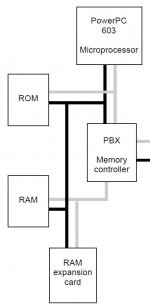Regardless of all of the supposedly amazing things you're doing with grafting high-end chips into Amiga desktops, the purpose of this thread is to install a new processor in a vintage laptop that has virtually no ventilation and only the most meager of heat sinks. Thus, if you want to use the thing on battery for more than 30 minutes and/or not have it shut down from thermal overload in about the same amount of time, a low-power cool-running chip such as the CX or CXe, with a maximum power draw of 6.7W@366MHz (and less at the maximum 333MHz it would run in a PowerBook 5x0), is something to be desired, not scorned. I mean if you want to build your own 7447-based PowerBook 5x0 upgrade (which will draw up to 23W@1GHz and top out at just 924MHz (28x33MHz)), then please do, but the rest of us really aren't ready to take it to that level just yet, seeing as how they're still trying to arrange to do the original 603e-to-740 processor swap being discussed here.
As far as the 750CX/CXe's package goes, yes it's wire-bonded and that's not the fastest technology ever, but it has a max of 700MHz and since its multiplier tops out at 10x (just like its contemporaries until the 750FX and 7450), the fastest it could possibly go in a 5x0-series machine is 333MHz, so it's kind of irrelevant. Also, yes, it has a heat spreader integrated to the top of the otherwise plastic BGA package. How is this a problem? It provides a large surface area directly bonded to the die, able to safely withstand a 2.2kg static load, and utilized to transfer heat to a proper thermal solution. Also the encapsulant on the underside of the package is designed to insulate the board from the die's heat, not transfer heat to it (the encapsulant is also a minimum of .244 mm away from the system board so there's no direct heat conduction). It doesn't transfer any more heat to the system board than would any comparable chip. In fact, I'd wager that it conducts less because normal FCBGAs have balls directly beneath the die.
Anyway it's just a recommendation for one of the Plan B variants: 750CX on an interposer on the original BGA-style upgrade card. The low ball count and low package profile of the 750CX make it easy to work with and keeps the total installed height within original specs so you don't have to fab custom heat sinks or anything, and keeping the original upgrade card greatly reduces cost and effort compared to designing and building a whole new card. You'd still have to reduce voltages though since the CX only runs a 2.5V I/O instead of the 3.3V of the 603e, but this is a requirement in order to use pretty much any chip outside of the originally desired 740.



